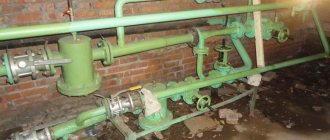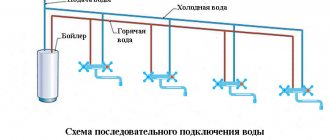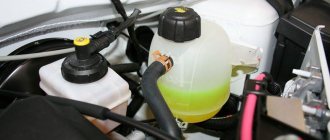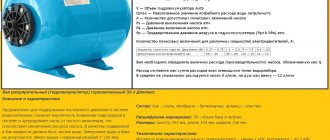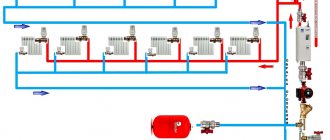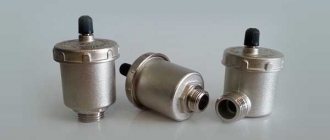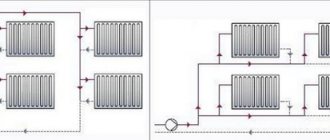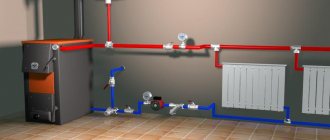One of the main problems when operating autonomous heating and water supply systems is pressure drop. Water hammer in the water supply and water heating system resulting from this sudden change can cause serious damage. He needs to be warned, don't you agree?
We will tell you how to prevent the phenomenon and neutralize its negative consequences, ensuring uninterrupted operation of the circuits. Here you will learn what methods are used to eliminate water hammer in systems that transport water to water taps and heating devices.
The article presented for review examines in detail the nature of water hammer. Preventive measures are listed to prevent the occurrence of a dangerous situation. For a visual understanding of this difficult topic, diagrams, photo illustrations and videos are attached.
Basic preventive measures
In addition to strict compliance with all established operating rules, an accident can be prevented if a number of preventive actions are carried out promptly and regularly.
The whole reason is that in the main heating or water supply system, absolutely all processes are closely interconnected. A water hammer unexpected by the user is just the final destructive stage, which may well lead to various negative consequences. All this happens against the background of the relatively poor technical condition of pipes that have been used for years. Changes in pressure and resulting vibrations only contribute to the formation of various cracks in the thickness of the metal. Over time, more serious defects arise, which, after the onset of water hammer, immediately appear in areas of too high internal stress. These can be various bends, mechanical connections and even welds.
Preventive manipulations include the following steps:
- Timely check of the pressure behind the elastic membrane of the expansion vessel in use. If during this procedure the technician discovers unsatisfactory results, then it is prohibited to operate the system without quality adjustments.
- Checking the functionality of the involved security groups. This applies to the air vent, safety valve, as well as the classic pressure gauge.
- Monitoring the position of the valves of the involved shut-off and control metal fittings.
- Periodically check the condition of all filters. These elements are responsible for retaining fine sand, classic scale, and rust fragments. If necessary, the technician will need to clean and then rinse the filters.
- Testing the system used for leaks. You also need to check the degree of wear of all elements.
Many experts recommend replacing the classic rigid pipe with a plastic product. It is more flexible in use and can expand quickly under pressure. But you need to be careful, as depressurization of the joints is possible.
A professional approach to prevention, which is aimed at overall maintaining the optimal condition of the heating and water heating system, necessarily includes basic types of work. It is not recommended to ignore this stage. This is due to the fact that heating repairs in a private house entail a large expenditure of finances and free time. All the described protective measures will be effective if you approach the work comprehensively. Only in such a situation can various undesirable consequences be neutralized and the life of the coordinated operation of the system extended.
Installing a high quality backwash filter
Changes and their reasons
Pressure surges indicate improper operation of the system. The calculation of pressure losses in a heating system is determined by summing up the losses at individual intervals that make up the entire cycle. Identifying the cause and correcting it early can prevent more serious problems that lead to costly repairs.
If the pressure in the heating system drops, this may be caused by the following reasons:
- the appearance of a leak;
- expansion tank settings failure;
- failure of pumps;
- the appearance of microcracks in the boiler heat exchanger;
- power outage.
How to increase the pressure in the heating system?
The expansion tank regulates pressure drops
If a leak occurs, all connections must be checked. If the cause is not visually identified, each area must be examined separately. To do this, the valves of the taps are closed one by one. The pressure gauges will show the change in pressure after cutting off a particular section. Having discovered a problematic connection, it needs to be tightened, after further sealing it. If necessary, the assembly or part of the pipe is replaced.
The expansion tank regulates differences due to heating and cooling of the liquid. A sign of a tank malfunction or insufficient volume is an increase in pressure and a further decrease.
A gap of 1.25% should be added to the result obtained. The heated liquid, expanding, displaces air from the tank through the valve in the air compartment. After the water cools, it will decrease in volume and the pressure in the system will be less than necessary. If the expansion tank is smaller than required, it should be replaced.
An increase in pressure may be caused by damage to the membrane or incorrect setting of the heating system pressure regulator. If the membrane is damaged, the nipple must be replaced. It's quick and easy. To configure the tank, it must be disconnected from the system. Then use a pump to pump the required number of atmospheres into the air chamber and install it back.
You can determine if the pump is faulty by turning it off. If nothing happens after switching off, it means the pump is not working. The reason may be a malfunction of its mechanisms or lack of power. You need to make sure that it is connected to the network.
If there are problems with the heat exchanger, it needs to be replaced. During operation, microcracks may appear in the metal structure. This cannot be eliminated, only replacement.
Why does the pressure in the heating system increase?
The reasons for this phenomenon may be improper fluid circulation or its complete stop due to:
- formation of an air lock;
- clogging of the pipeline or filters;
- operation of the heating pressure regulator;
- continuous replenishment;
- overlapping shut-off valves.
How to eliminate differences?
An air lock in the system does not allow liquid to pass through. The air can only be vented. To do this, during installation it is necessary to provide for the installation of a pressure regulator for the heating system - a spring air vent. It works automatically. The new model radiators are equipped with similar elements. They are located at the top of the battery and operate in manual mode.
Why does the pressure in the heating system increase when dirt and scale accumulate in the filters and on the walls of the pipes? Because the flow of fluid is hampered. The water filter can be cleaned by removing the filter element. Getting rid of scale and blockages in pipes is more difficult. In some cases, washing with special means helps. Sometimes the problem can only be fixed by replacing a section of pipe.
When the temperature rises, the heating pressure regulator closes the valves through which liquid enters the system. If this is unreasonable from a technical point of view, then the problem can be corrected by adjustment. If this procedure is not possible, the unit should be replaced. If the electronic make-up control system fails, it should be adjusted or replaced.
The notorious human factor has not yet been canceled. Therefore, in practice, shut-off valves overlap, which leads to increased pressure in the heating system. To normalize this indicator, you just need to open the valves.
Setting up and balancing heat supply
Preventive actions can not only reduce the consequences of an accident, but also prevent equipment malfunctions, both in an ordinary apartment and if you have an alternative heating system installed in a private home.
It is necessary to monitor the condition of the Mayevsky taps (device), thermostats, circulation pump, shut-off valves (read about faucets for hydromassage baths on board the bathroom here).
In cases where leaks or operational difficulties are detected, the equipment must be replaced, and the connections are either rebuilt or replaced with new ones.
To ensure uninterrupted operation of the pump, backup power sources should be installed.
This, together with a bypass (about the installation for a heated towel rail, is written here) will allow you to avoid an increase in pressure during a power outage.
IMPORTANT! Fluid circulation disorders are caused by several reasons. These include clogged coarse filter, airing of the system (how to remove), lack of water.
It is necessary to constantly monitor the fluid level and heating of heating devices.
If the radiator does not warm up or does not warm up completely, then air has formed in the system, which is removed using the Mayevsky valve.
Possible consequences of water hammer and its dangers
You can recognize the signs of the phenomenon by extraneous sounds in the system: clicks, knocks, collapses. Visual signs will also help: leaking taps, mixers, crimp fittings with rubber gaskets.
When the water supply system is subjected to frequent water shocks, even of weak force, gaskets and seals are squeezed out first. Violation of the tightness of the system can lead to the appearance of areas of deformation and rupture of pipes.

As a result of increased pressure, the water supply is disrupted. But this is not the only trouble. If a water hammer leads to a complete rupture of a pipe, for example, in an apartment building, the entire building is left without water. The flow of liquid spoils the property of the apartment owners, and the neighbors on the lower floors are flooded. As a result, work on the repair and restoration of several residential properties took place.
Water hammer in a hot water supply system threatens, in addition to permanent damage to property, burns. Danger occurs when the heating system depressurizes, where the medium maintains a temperature of +70C and is constantly under pressure. A rupture of a battery or pipeline during the winter heating season will damage the system. Frosts will complete the destructive work - the pipeline will have to be replaced.
Let's consider the city's heat supply system as a whole.

Heat is produced by heat generating companies in boiler houses or thermal power plants and then with the help of pumping units along heating mains, as well as through in-house pipes, heat in the form of hot water enters our radiator and bathroom or kitchen faucet. Everything seems simple - there are strong steel pipes everywhere, they are usually closed, there is no access to them for unauthorized persons. Imagine there are places where water hammers occur several times a day.
Who does the water hammer?
The reason for their occurrence is people (“workers”). I think that they arrange them not out of malice, but out of laziness and stupidity. And these troubles occur due to improper operation of pumping stations (PNS)!
Here is a verbatim extract from the reference book “Operation of water supply, sewerage and gas supply systems”, authors V.D. Dmitriev. et al., Stroyizdat, Leningrad branch, 1988: “...Before operating a pumping station, you should first check the possibility of starting pumps with an open pressure valve for the resulting overload of the electric motors of the pumps and the resulting water hammer in the network. If it is impossible to start pumps in automated installations with an open valve, the start-up circuit should include operations for opening it after starting the pump and closing it before it stops...”
In other words, if there is no automatic soft start of a centrifugal pump, it is necessary to: close the pressure valve after the pump, turn on the pump, and after stabilizing the pressure on the pressure line, smoothly open the valve in the direction of the consumer. There is a similar point in any instructions for starting and operating a centrifugal pump.
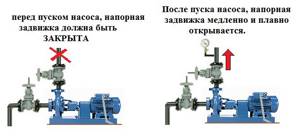
The best way to cope with this is with automation, which, after pressing the “start” button, will slowly increase the speed of the electric motor, and thereby gradually increase the pressure in the pressure pipeline. But, unfortunately, a small number of pumping stations are equipped with such automation.
What's really going on?
To do this, you need to decide on the pumping stations and their balance. Typically, all booster pumping stations (PNS) supplying coolant can be divided into three types:
— PNS of heat generating companies, in them everything usually works properly in accordance with the rules and instructions, because Given the colossal power of the existing pumps and their incorrect start-up, the accident would be catastrophic for the heating system of the entire settlement.
— PNS quarterly (may belong to different organizations, but, as a rule, they belong to specialized energy companies with qualified personnel). Quite powerful pumps are installed in the quarterly PNS, and their main task is to increase the pressure of the coolant and distribute it throughout various areas of the settlement. These PNS also have relative order.
— PNS are local, these pumping stations can belong to anyone, who and how they managed to build them is not always known.
The simplest scheme
connecting a multi-storey building through a local pumping station from an open heat supply system (without heat energy meters and automation).
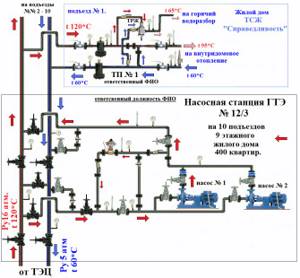
It is precisely from the improper operation of local pumping stations that there is the highest probability of getting a water hammer in the heating and hot water supply system of a residential building.
Here are some examples:
1. PNS belongs to a cooperative building or HOA.
As a rule, in this case, the pumping station is serviced by a mechanic, to whom the housing cooperative or homeowners association can allocate, for example, 3,000 to a maximum of 5,000 rubles per month, and what’s all this about turning the pump on and off. So he turns it on... pressed the button and that’s enough!? For 3000 rubles to turn the valves every time? No way! And if something happens, try to prove that you turned on the pump according to the instructions and that’s it!
2. The PNS belongs to a specialized organization - the City Thermal Energy Company (GTE), which is also a heat supply organization, because resells thermal energy.
To reduce costs, GTE creates a 24-hour service for the repair and operation of the pumping station. According to the schedule, a team of 2-3 people travels around about 100 pump stations once or twice a day to carry out operational repair work in them. Here are some examples of these works:
— prompt switching of pumps from working to standby and vice versa;
— tightening the stuffing box seals of pumps and shut-off valves;
— control and regulation of coolant parameters and so on.
Imagine that a mechanic must visit 100 pumping stations. Even if by car... he must manage to switch 200 pumps, tighten several dozen oil seals, make entries in 100 journals and much more, and do you think he will turn the valves? No, because he physically doesn’t have enough time, and if he doesn’t have time... he’ll be deprived of his bonus. But you can argue that if you do not close the valves, then the parallel (non-working) pump with the valves open will not allow the pressure to rise and will act as a jumper, by analogy with electricity there will be a short circuit. There is an easy way out. Let's install a check valve on the pressure line of each pump and then... You don't have to close any valves. And such unfortunate workers think: “... there will be a water hammer in a house for which I am not responsible, but I will have time to complete everything and receive a bonus.”
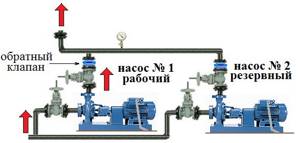
And if an accident occurred, then, as in the first case, prove... I turned on the pumps according to the instructions and that’s it!
From the above, we can conclude that 99% of the water hammer in your house came from the local (nearest) pumping station.
If you are flooded due to water hammer, what should you do?
We can give you some advice on what to do, and more importantly, what not to do.
If you think you got wet due to water hammer... ask your neighbors if they have had anything similar, take photographs of all the accident sites, immediately each victim must call the emergency service on their own (even at night), record the time of the call and who accepted the call, do not listen to the neighbor that he has already called the emergency response. Call yourself.
Upon arrival of the emergency team, find out the positions and names of the workers. Record your arrival and departure times. Record everything they do, follow the emergency workers collectively, remember every word and action. Try to get a written conclusion from the arriving emergency workers about the causes of the accident, even if it is initially incorrect or incredible, as long as it is written.
The next day, collectively or individually, notify the management company (MC) in writing about what happened. In the application, ask to put a mark on the incoming registration of the application. Try to convince the employees of the management company to immediately draw up a report on the causes and consequences of the accident, demand that the culprit of the accident be indicated in the report.
And here's what's next... the most difficult thing. Let us give a brief diagram of your highly probable “ordeals.”

So, you have received all the acts in your hands. Now you want to receive a monetary refund. If your property is insured against such an event, we congratulate you.
If you don’t have insurance, go to the management company and get an answer like: “....Everything is working fine with us, the equipment works without failures and accidents, we are not to blame, go to the heat supply organization...”, there they will advise you to return to the management company or contact the heat generating company, where they simply won’t talk to you. Naturally, make all requests in writing with registration; be sure to wait for written responses, otherwise the court may give you a negative answer after considering the claim. At best, everything will take you 1 month, at worst, up to six months. A little advice, contact all organizations at once, and each victim must apply independently; the more documents, the better.
Another tip . If a pipe bursts due to water hammer, a radiator ruptures, etc. only in your apartment, you don’t have to complain anywhere and don’t go to court, you’ll be wasting your time and money, you won’t be able to prove anything, it’s been verified! In this case, it is better not to do anything, you will save your nerves. Even if you hire an expensive lawyer, he will advise you to hire an expert, this will not help either, not a single expert has ever given a clear and categorical opinion in court, in any case he will be confused and chattered, example:
Judge to expert: “The plaintiff is trying to prove that the sun rises in the east, what can you say to this?”
Expert: “Yes, of course the sun always rises in the east, this is the law of nature”
Defendant: “But according to our personal observations and according to new discoveries, the sun does not move steadily during sunrise and for an immeasurably small unit of time the sun can stop or even go backwards, what do you say to this, expert?”
Judge: “Expert answer!”
Expert: “M..., of course, I’m not familiar with new theories and discoveries, but the sun always rose in the east, it couldn’t be any other way.”
Defendant: “I ask the expert to give a definite answer”
Expert: “Yes, of course the sun always rises in the east, but we don’t know everything about the laws of nature and it is possible that everything could be different, although this is unlikely...!”
The court's opinion about the expert is zero. Now imagine that such a dialogue is about water hammer, how can one give a conclusion and determine exactly where and why the water hammer occurred, and even more so if the accident occurred in a single place.
There is only one possible case: if the owner of the pumping station voluntarily accepts the blame or you have a reliable witness who saw the incorrect actions of the pumping station maintenance personnel at the very moment of your accident, believe me, you will not receive such happiness.
Remember that it is you who needs to prove the defendant’s guilt, and how will you do this, because you do not have a single fact except the act (paper) and emotions. However, the report will be drawn up describing the consequences, not the causes of the accident. Keep in mind that the defendants will come to court with a bunch of lawyers and witnesses, and you are alone, they will simply talk to you, the defendants will bring in perhaps the guilty mechanic, but he will state that he turned on the pump according to the instructions and even a log with a signature will show the pressure gauge readings, that there was no water hammer. They will prove to you that it was you, it was you who bought and installed the faulty part or the burst device, and that you should be the defendant, and a counterclaim may be filed against you, etc. and so on.
But if you still decide to fight in court to the end, be patient and, for money, hire a qualified lawyer and experts who have worked in heat supply organizations (do not invite theorists from institutes), and one more piece of advice: file a claim in court with a request to recognize the entire chain of service providers: housing cooperatives or homeowners associations, management company, operating organization, all intermediate heat resellers, owners of pumping stations and pipelines, up to and including the heat generating company, let the court independently look for a specific culprit or determine the degree of guilt of each of the defendants, you have a chance to win the case will increase significantly. But even in this case, even if you win the trial, it may turn out that repairing the stains at your own expense could cost you less and less nerves.
And the last piece of advice, if the district court makes a decision not in your favor, believe me, there is absolutely no point in appealing it, it has also been tested many times!!! In these types of cases, higher courts change the decisions of the lower court in a ratio of 1/1,000,000.
Causes of water hammer
The most important reason is the sudden closure of the shut-off valves. If the water flows in a thin stream, the risk is minimal, but when the tap is opened/closed abruptly, the danger increases to the maximum.
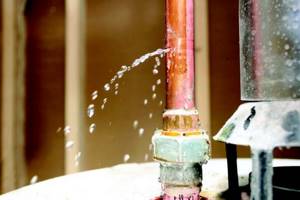
Why else does water hammer occur in the water supply system:
- When powerful pumps are turned on abruptly. Occurs when the power supply to facilities equipped with powerful pumping stations is unstable.
- If there are air pockets in the water supply or heating system. Therefore, before putting closed systems with a liquid carrier into operation, the air must first be removed.
Today, water hammer is considered the most common factor in the failure of water supply systems. This is due to the advent of new shut-off valves that do not require long turns of the valve (taucet) to open/close water.
Other ways to combat water hammer
One of the possible options for neutralizing water hammer has already been voiced - close the taps smoothly. But this is not a panacea, and it is inconvenient in our fast-paced times. And there are also household appliances, you can’t teach them. Although, some manufacturers take this point into account, and the latest models are made with a valve that smoothly shuts off the water. This is why compensators and neutralizers are becoming so popular.
You can combat water hammer using other methods:
- When installing or reconstructing water supply or heating systems, insert a piece of elastic pipe in front of the source of water hammer. This is reinforced heat-resistant rubber or PPS plastic. The length of the elastic insert is 20-40 cm. The longer the pipe, the longer the insert.
- Purchase of household appliances and shut-off and control valves with smooth valve movement. If we talk about heating, problems with warm water floors are often observed. Not all servos operate smoothly when closing the flow. The solution is to install thermostats/thermostats with a smooth piston stroke.
- Use pumps with soft start and stop.
Water hammer is a truly dangerous thing for a closed system. He breaks radiators and bursts pipes. To avoid problems, it is better to think through control measures in advance. If everything is already working, but problems arise, the smartest and easiest way is to install compensators. Yes, they are not cheap, but repairs will cost more.
Introduction of shock absorbers
Hydraulic accumulators and dampers sold today are capable of simultaneously performing several important functions. They not only collect liquid, but also eliminate excess water from the system, and also help prevent various undesirable manifestations. Hydraulic accumulators perform all the functions of compensating units. They are installed only in the direction of the main water flow in those sections of the heating circuit where the likelihood of a sudden decrease or increase in the level of measured pressure is especially high.
A kind of damper, as well as a hydraulic accumulator, in practice, is a capacious steel flask that can easily hold up to 35 liters of liquid. They include two sections separated by a durable rubber partition. In the event of an increase in pressure, all water hammer is redirected to the reservoir. Thanks to the bending of the involved membrane at the moment of a sharp increase in indicators, specialists are able to achieve the effect of forced expansion of the circuit.
The shock-absorbing elements are pipes made of heat-resistant reinforced rubber or elastic plastic. To achieve the desired effect, it is enough to use a product 35 centimeters long. If the pipeline is long, then the shock absorber section must be increased by at least 12 cm.
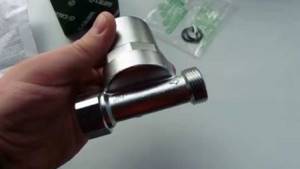
High-quality water hammer absorber
What is water hammer in a water supply system?
Water hammer is a short-term powerful increase in the pressure of the liquid that circulates in the pipes. The pressure increases due to changes in flow speed.

The sign of the pressure change affects the type of water hammer:
- positive - in which the pressure increases due to the sudden closure of the valve or the activation of the pump unit;
- negative - in which the pressure increases due to the pump stopping.
According to the laws of physics, even when the tap is suddenly closed, the water continues to move. Only the flow closest to the valve stops; the remaining layers continue to flow. The collision of the stopped and moving layers causes an increase in pressure. If you imagine that the entrance to a moving crowd has been abruptly closed, then the first rows have already stopped - the next ones bump into them, continuing to walk, the result is a crush. Water also acts, causing water hammer.
The pressure increases instantly, the level increases by several tens of atmospheres. The consequences cannot be avoided.
Water hammer theory
The occurrence of the phenomenon is possible only due to the lack of compensation for pressure drops. A surge in one place causes a force to spread throughout the entire length of the pipeline. If there is a weak point in the system, the material may become deformed or fail completely, creating a hole in the system.
The effect was first discovered at the end of the 19th century by Russian scientist N.E. Zhukovsky. He also derived a formula by which to calculate the period of time required to close the tap in order to avoid unpleasant consequences. The formula looks like this: Dp = p(u0-u1), where:
- Dp – pressure increase in N/m2;
- p – liquid density in kg/m3;
- u0, u1 are the average water speed in the pipeline before and after closing the taps.

To know how to prove water hammer in a water supply system, you need to know the diameter and material of the pipe, as well as the degree of compressibility of water. All calculations are carried out after establishing the water density parameter. It differs in the amount of dissolved salts. The speed of propagation of water hammer is determined using the formula c = 2L/T, where:
- c – designation of shock wave speed;
- L – pipeline length;
- T – time.
The simplicity of the formula allows you to quickly determine the speed of propagation of the impact, which, in essence, is a wave with oscillations of a given frequency. Now let’s talk about how to find out fluctuations per unit of time.
For this, the formula M = 2L/a is useful, where:
- M – duration of the oscillation cycle;
- L – pipeline length;
- a – wave speed in m/s.
To simplify all calculations, knowledge of the shock wave velocity upon impact for pipes made of the most popular materials will allow:
- steel = 900-1300 m/s;
- cast iron = 1000-1200 m/s;
- plastic = 300-500 m/s.
Now you need to substitute the values into the formula and calculate the vibration frequency of the water hammer on a section of a water supply pipe of a given length. The theory of water hammer will help to quickly prove the occurrence of the phenomenon and prevent possible risks when planning the construction of a house or the replacement of a plumbing or heating system.
Technical means of protection
The system must be maximally protected from rash human actions, improper operation and untimely and incomplete maintenance. To achieve this, there are a number of technical solutions to minimize the consequences of fluid pressure surges in water supply and heating networks and prevent their occurrence.
Pipe replacement
To do this, it is necessary to inspect the entire pipeline; old steel pipes should be replaced with modern ones made of polymer materials. They are more reliable, practically resistant to corrosion and last longer. In this case, pipes must be selected taking into account operating conditions (pressure and temperature in the network) with a small margin in parameters. To reduce the flow rate, it is advisable to choose products with the maximum possible diameter for the pressure. Find a middle ground.

Modern reliable pipes and connecting elements made of polymer materials Source santehnika-nk.ru
Replacing shut-off valves
Replacing ball valves with valve valves can be called a return to the past, but this will avoid sudden pressure changes regardless of how the shut-off valves open and close. It is not necessary to change all locking devices; you can limit yourself to only those that are critical to the system.
Basic methods of protection
To protect materials, equipment and communications from water hammer, the following methods are used:
- Installation of thermostats with built-in shunt;
- Inserts made of plastic material;
- Installation of membrane devices;
- Control of pump operating modes based on data from the pressure sensor in the system;
- General preventive measures.
Temperature regulators with a built-in shunt are installed as shut-off valves. A shunt is a small-diameter tube that allows excess coolant to pass through when pressure increases.
Steel elements are most often subject to destruction from water hammer due to the rigidity of the structure and the lack of a shock-absorbing effect. To create a shock absorber, small sections of polymer pipes with good flexibility are often cut into place. During a water hammer, they compensate for the impact force by bending without being damaged.
Hydraulic accumulators and expansion tanks also do a good job of increasing pressure, taking on the excess pressure. A membrane made of rubber or polymer bends and compresses the air in the air chamber. Water from the heating flows into the freed space, reducing the overall pressure in the system.
Circulation pumps are equipped with a pressure control system. The sensor monitors the water pressure in the network. When the value increases, it sends a command to reduce the pump speed. This system is applicable for pumps with variable speed control of the impeller rotation speed.
General preventive measures to prevent water hammer and their consequences:
- Perform smooth control of shut-off valves;
- Turn on the pumps at low speed;
- Check the functionality of air vents and safety valves;
- Promptly and regularly bleed air from the equipment;
- Regularly carry out visual inspections for the integrity of structural heating elements;
- Monitor the integrity of the membrane of the expansion chambers.
Water hammer is a common and dangerous phenomenon in heating networks. Timely prevention will save heating communications and equipment from damage and preserve their integrity and performance.
Owners of private apartments and houses often hear sharp, distinct blows in the equipped heating pipeline. Many people do not pay due attention to this phenomenon, but the outcome of the situation can be very different. Specialists often have to eliminate the results of destruction of important parts.
In some cases, injury to residents cannot be ruled out. Water hammer in an equipped heating system is the main cause of most breakdowns and destruction of heating equipment. A high-quality and timely solution to this issue is of great importance for the stable and trouble-free operation of the system.
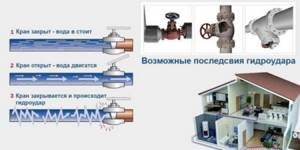
Classic consequences of an emergency
Setting up the heating system
After installation and repairs are completed, the heating system is adjusted or, in other words, balanced.
Errors made during the design and construction process must be eliminated before the thermal circuit is put into operation, so that an accident caused by a water hammer does not occur in the future. Operations performed when setting up a heating system:
- measurements of the outer diameters and length of pipes at each section; in case of deviations from the design, errors are eliminated;
- identifying the presence of air jams in a closed loop and eliminating them;
- checking the liquid level when starting a heating pipeline with an expansion tank.
The setup helps make the system reliable with efficient heat consumption. A thermal circuit with natural circulation reacts especially sensitively to shortcomings. Sometimes cleaning the filter at the liquid inlet to the boiler normalizes the water circulation.
After debugging the equipment and fittings of the system, the thermal regime is balanced and the media heating is adjusted. If this is not done, the radiators closest to the heating boiler will be hot, and those further away will be cold. In this case, the heater operating mode will be uneconomical.
To balance the heating, a valve of a special design is installed at the input of each battery or the degree of heating is adjusted by installing washers of different diameters.
Retrofitting a thermostatic valve
This auxiliary part is a compact tube. The final clearance can vary from 0.2 to 0.6 millimeters. The shunt is mounted in the direction of the circulating fluid. The main task of the part is to gradually reduce the pressure when overloads are detected. When designing autonomous systems, the shunting method must be used, since only in this case can the new pipeline be protected from failure.
This effect is due to the fact that worn-out pipes contain rust and other debris, which is a serious obstacle to achieving the desired result. It is for this reason that when using a shunt, it is advisable to install high-quality water filters at the very outlet of the equipped heating circuit.
Protecting the installation from negative influences
Experts are accustomed to using time-tested methods of protection against water hammer. Even at the first stage of design, experts provide for the presence of all the necessary working units and parts, which are used only as a whole. The final choice of protection elements depends on the characteristics of the equipped heating system: the area of the home, the type of pump, the length and diameter of the pipes. Only a professional who has previously studied all the nuances of the property can select the entire set of devices as rationally as possible.
The video provides useful information on how to properly and effectively deal with water hammer:
Short description
A very common water hammer in an equipped high-quality heating system is a unique phenomenon that is based on the dynamics of various substances. The manifestation itself differs in that with periodic changes in the flow rate of the working fluid, an increase in pressure indicators is observed. The main coolant is water, the main indicator of which is incompressibility. During the circulation of the charged coolant through pipelines and heating elements, various hydraulic obstacles may arise along its path. In most cases, these are turns, sudden changes in the diameter of pipelines, as well as shut-off and control valves.
Under unfavorable conditions, the coolant can damage those elements that present strong hydraulic resistance to the flow. These can be convectors, pipe turns, various devices, radiators and even boiler heat exchangers.
An accident may well occur as a result of gradual wear and tear of the operating structure and its elements, or as a result of the sudden impact of a strong jump in performance. In all situations, the consequences of water hammer entail material waste to eliminate the leak. In order not to find yourself in such a situation, you should understand the basic reasons for the formation of water hammer. The consequences of an accident are always unpredictable, ranging from the most common breakdown of the circulation pump to large-scale flooding of the entire house. It all depends on the quality and power of the system.
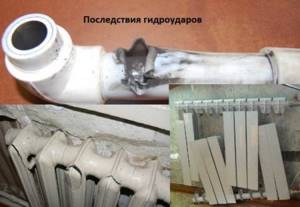
The most common consequences of water hammer
Conclusion
The issue of preventing water hammer in the system should be in the area of attention of any owner, be it a multi-storey building or a private building. If an emergency situation occurs in winter, there will be plenty of problems. The time to eliminate the fault increases significantly, especially if the rupture occurred on a section of the highway passing through the territory in frozen soil. It is clear that it is better to prevent water hammer than to restore the functionality of liquid communications. To compensate for damage from an accident, you will have to spend both time and money, and in some cases quite a lot.
Do you want to eliminate the risk of water hammer in heating and water supply circuits? Contact ALFATEP. Our specialists will prepare a design for the engineering system and select the necessary equipment. In the online store alfatep.ru products from well-known manufacturers at their prices - quality is guaranteed. You can ask any questions or leave a request by calling 8 (495) 109 00 95 – calls within the Russian Federation are free – or on the website (section “Contacts”). Real prices, good discounts and bonuses, customer loans, fast delivery of goods: we do everything for the convenience of customers - please contact us.
Gradual shutdown of the system
This is one of the most important requirements when starting and subsequently shutting down a heating installation. All optimal parameters are described in detail in the basic accompanying documents. The whole reason is that the accumulated energy of the water hammer, due to the increased strength of the pipe walls, may not act with all its power.
This feature is achieved due to lightning-fast bending in the desired direction. With the same final impact force, the power of influence on a certain area of the system will be significantly reduced. Thanks to the smooth switching on, specialists are able to significantly extend the rate of pressure build-up, minimizing the likelihood of damage to the heating system of a cottage or apartment building.
The batteries gurgle
The next cause of noise in metal heating pipes is air. If something is continuously seething and gurgling in the battery, like in the stomach of a sick cow, that’s it, darling. Soundproofing heating pipes, even if it were done, would not give anything - the sound will be heard through the walls of the radiator.
Are you on the top floor of a house with bottom drain (where both the heating system supply and return pipes are located in the basement)? Then look for a Mayevsky tap on the radiator or jumper between adjacent rooms - a device that helps bleed air.
In all other cases, it is worth looking for a counter-slope (of course, if the heating system works normally in all other respects, except for noise). A radiator hanging skewed or a section of the supply line to it, which is lower near the riser than near the battery itself - this is what you have to fix, most likely in the summer - stopping the heating system in winter for a long time, especially in the harsh climate of Siberia or the Far East, is unlikely would be a good idea.
